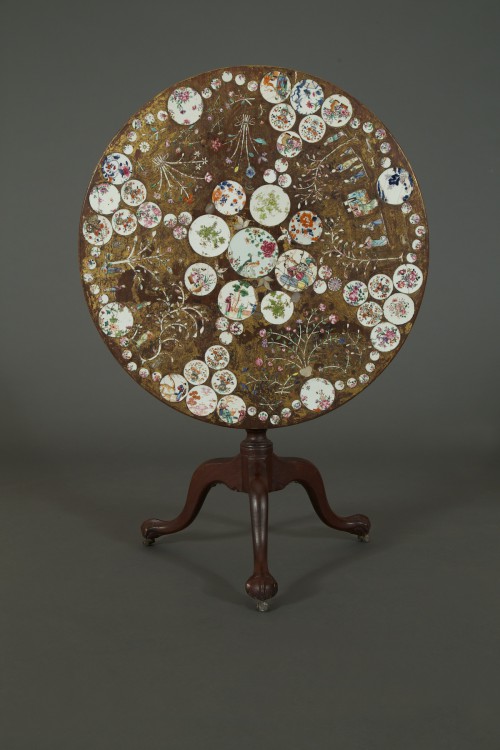11161 AN EXTRAORDINARY MAHOGANY GEORGE III BIRDCAGE TRIPOD TABLE, THE TOP SET WITH A DECORATIVE SCHEME EMPLOYING ORIENTAL CERAMIC FRAGMENTS AND MOTHER OF PEARL English. Circa 1780. The Inlays First Half of the Nineteenth Century. Measurements: Height: 29 1/2″ (75 cm) Diameter: 33 3/4″ (85.7 cm)

Research
Of mahogany with ceramic and mother of pearl. The circular tilt-top inlaid with Chinese porcelain circular discs of varying sizes depicting flowers, animals, and figures; an inlaid porcelain figural group; and fragment of porcelain and mother of pearl inlaid in the form of trees, bouquets, and flower-filled vases. The carved tripod base with vase shaped stem from which issue three downswept legs ending in a ball and claw foot.
Provenance:
The Property of Lady Bertha Baron
Sold, Sotheby’s, London, 10 April 1964, lot 157.
In the English antiquarian tradition, the top of this highly unusual table is mounted with a wide ranging group of fragmentary export wares, from early 18th century Imari and Yongzheng famille rose through late Qianlong as well as some 19th century examples.
Certain painted designs on the circular porcelain fragments are repeated and were therefore probably taken from the same tea service. Other fragments carefully cut and arranged as mosaics in the form of bouquets, trees and vases of flowers. These designs also include the inlay of mother of pearl, each piece engraved to evoke floral decorated porcelain itself. The mother of pearl inlay forms human figures and dogs at play. Finally, individual Oriental figural groups have also carefully been cut out of porcelain and integrated into the vignettes.
The only other example of furniture that employs earlier “cut-up parts of plates and dishes—dating from roughly 1780 to 1830”1 is a pair of cabinets now in the collection of the Victoria and Albert museum on display at Highcliffe Castle, Dorsetmade. These cabinets were made c. 1830 and come from the collection of Lord Stuart de Rothesay, who served twice as British ambassador in Paris (1815-1824 and 1828-1830).
The birdcage support in the base of the present table, comprised of two square planks joined by columns at the corners, enables the top to both tilt and rotate, allowing the greatest versatility of placement within a room.
The table was formerly in the collection of Lady Bertha Baron (1899-1981), the wife of Sir Edward S. Baron (1892-1962), son of Bernhard Baron, the English philanthropist.
Footnotes:
1. https://collections.vam.ac.uk/item/O71519/cabinet-unknown/


Comments are closed.